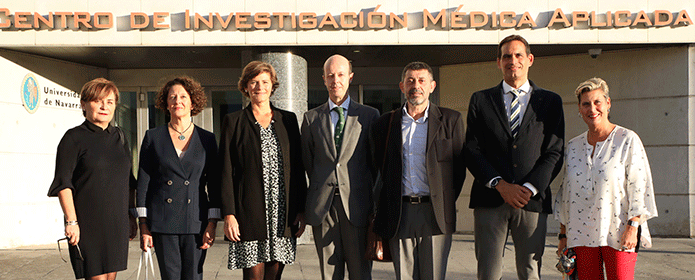Navarre is emerging as a community of reference letter in precision cancer diagnosis
The project DIANA, coordinated by the CIMA and the Clínica Universidad de Navarra, in partnership with the Complejo Hospitalario de Navarra (CHN) and Navarrabiomed will facilitate the design of personalized treatments.

"Navarra is emerging as a community of reference letter in the precision diagnosis of cancer," says Dr. Felipe Prósper, coordinator of project DIANA, a public-private partnership aimed at implementing precision medicine in Navarra. The project, financed by the Government of Navarra, involves researchers from the research center Médica Aplicada (CIMA) and the Clínica Universidad de Navarrain partnership with the Complejo Hospitalario de Navarra (CHN) and Navarrabiomed.
According to the latest cancer registry published in Navarra, during the period 2008-2009, 10,316 new cases of tumors were registered in the population of Navarra, of which 8,722 were infiltrating malignant tumors. These data highlight an important public health problem with great repercussions on the health care system.
"On many occasions, the current diagnosis of cancer requires invasive techniques, is based on morphological criteria and does not allow the most appropriate treatment to be selected according to its molecular markers. All of this leads to lower efficacy, as well as patient discomfort and higher economic costs," says Dr. Ruth Vera, head of the Medical Oncology Service of the Navarra Hospital Complex and manager of group of research of the same area in Navarrabiomed. Likewise, according to Dr. Prósper, director of the Hemato-oncology Program of the CIMA and co-director of the Hematology Service of the Clínica Universidad de Navarra, "in the case of hereditary tumors, if it is not possible to advance in the detection of genomic alterations that determine the predisposition to cancer, family history alone is not sufficient to reach a diagnosis".
New, more precise and less invasive techniquesThe project DIANA has as goal to implement in the clinical internship new sequencing technologies for the precision diagnosis of cancer in Navarra. To this end, samples from patients with breast, lung, liver, colon, hereditary cancer and hematological tumors will be studied in both centers, and new, more precise and less invasive molecular techniques will be implemented. In addition, as part of project , programs of study will also be carried out to identify new therapeutic targets in these patients that will allow new treatments to be developed at design .
"An essential aspect of this partnership is the integration and analysis of all the information obtained through the development of computational techniques for the analysis of the data genomes," say the researchers.
This is a pioneering study that, based on new technologies, will transfer the results to the clinical internship to prolong the lives of patients and optimize their treatments. "The possibility of developing this project jointly with the CHN will allow us to turn our community into a node of knowledge and development economic in this field", considers Dr. Prósper.
reference letter center in northern SpainOne of the most advanced techniques in precision diagnostics is the use of liquid biopsy. "The detection of a cancer by means of a simple blood extraction and the determination of markers in the circulating DNA opens up the possibility of an earlier diagnosis - with the consequent improvement in prognosis - more precise, and with much less discomfort for the patient. At the same time, financial aid allows us to monitor the response of the disease to treatment", comments Dr. Vera.
In this sense, CIMA Lab Diagnostics of the University of Navarra is currently one of the most experienced laboratories in the development and implementation of molecular techniques for the diagnosis of cancer, which has made it the center of reference letter of more than 30 hospitals in northern Spain.
The project DIANA is part of the scientific activity of the high school de research Sanitaria de Navarra (IdiSNA), a public-private partnership for the promotion of biomedical research in Navarra.
